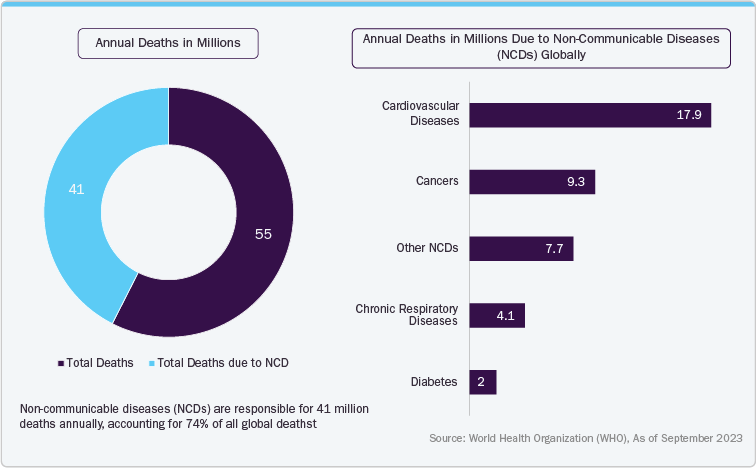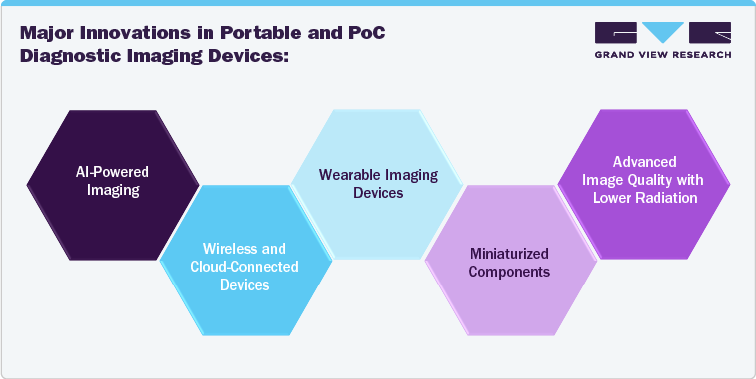Overview
Portable and point-of-care diagnostic imaging devices have brought a significant transformation to healthcare, allowing clinicians to offer real-time diagnostic capabilities in diverse settings such as hospital bedsides, ambulatory care centers, and even remote or rural areas. This has improved the timeliness of diagnostics, enhanced patient outcomes, and helped reduce the cost of healthcare delivery. As technological innovations continue to shape the medical imaging landscape, the market for portable and point-of-care devices is expected to see sustained growth. This report delves into the key innovations driving this growth, examining the technologies behind these devices, the companies leading the charge, and future opportunities.
Market Dynamics And Growth Drivers
The demand for portable and point-of-care diagnostic imaging devices is on the rise, fueled by multiple trends in global healthcare. One of the major drivers is the increasing prevalence of chronic diseases such as cardiovascular disorders, diabetes, and cancer.
According to the World Health Organization (WHO), as of September 2023, noncommunicable diseases (NCDs) are responsible for 41 million deaths annually, accounting for 74% of all global deaths. Among these, 17 million people suffers to NCDs before reaching the age of 70, with 86% of these premature deaths occurring in low- and middle-income countries. NCDs disproportionately affect these regions, where 77% of all NCD-related deaths take place. Cardiovascular diseases are the leading cause, resulting in 17.9 million deaths each year, followed by cancers (9.3 million), chronic respiratory diseases (4.1 million), and diabetes (2.0 million, including deaths from kidney disease caused by diabetes). These four disease groups alone contribute to over 80% of premature NCD deaths. Risk factors such as tobacco use, physical inactivity, harmful alcohol consumption, unhealthy diets, and air pollution significantly increase the likelihood of NCD-related deaths. Addressing these issues through the detection, screening, treatment, and palliative care of NCDs is critical to reducing their global impact.

The growing prevalence of NCDs, particularly in low- and middle-income countries, is driving the demand for advanced diagnostic and treatment solutions, including portable and point-of-care imaging devices. As these diseases require early detection and continuous monitoring, the need for accessible, cost-effective diagnostic tools is increasing. Portable imaging devices enable healthcare providers to reach underserved populations, offering timely and efficient diagnostics that are crucial in managing NCDs. Consequently, the rising burden of NCDs is expected to significantly fuel market growth in this sector.
This significant increase in the aging population is driving the demand for portable diagnostic devices. Elderly patients, particularly those in nursing homes or receiving home-based care, often encounter challenges in accessing traditional imaging services. Portable diagnostic tools, such as ultrasound, X-ray, and CT systems, can be brought directly to these patients, providing a more comfortable and efficient alternative to hospital-based care. The convenience and accessibility offered by portable imaging devices make them a critical component in managing the healthcare needs of an aging global population, further fueling the growth of this market.
According to World Health Organization, it is projected that 1 in 6 people globally will be aged 60 years or older by 2030, with the population in this age group expected to grow from 1 billion in 2020 to 1.4 billion. By 2050, the population of those aged 60 and older will have doubled to 2.1 billion, and the number of individuals aged 80 years or older is anticipated to triple, reaching 426 million. This demographic shift towards an aging population commonly referred to as population aging, initially began in high-income countries, such as Japan, where 30% of the population is already over 60 years old. However, this trend is now accelerating in low and middle-income countries, which are expected to house two-thirds of the world’s population over 60 years by 2050.
Moreover, the healthcare sector's shift towards value-based care models, which emphasize cost-efficiency and patient-centered services, has made PoC diagnostics an attractive solution. These devices help reduce hospital readmissions, speed up diagnoses, and decrease treatment costs. Alongside this, the rapid development of technology, which enables the miniaturization of sophisticated imaging equipment, is providing companies with the means to create lighter, faster, and more affordable diagnostic devices.
Key Portable and Point-of-Care Diagnostic Imaging Devices
Ultrasound is one of the most widely used portable imaging technology. Portable ultrasound devices are highly valued in settings such as emergency departments, maternity wards, and outpatient clinics, where speed and non-invasive diagnostics are crucial. These devices can offer real-time imaging results, enabling quick assessments of internal structures like the heart, abdomen, and blood vessels. Furthermore, advances in wireless connectivity and AI-based image analysis are enhancing the functionality of portable ultrasound devices, allowing for remote diagnostics and improving accessibility in underserved regions. Examples include Philips Lumify which connects to a smartphone or tablet, allow clinicians to perform high-quality imaging for cardiac, abdominal, and vascular assessments; GE Vscan Air, a handheld ultrasound device known for its wireless capabilities and high-resolution imaging, ideal for remote diagnostics. Additionally, the Butterfly iQ+, a pocket-sized ultrasound device with AI-enhanced imaging, provides comprehensive body scans and is especially beneficial in underserved regions where access to healthcare is limited.
Portable X-ray systems are another vital tool in point-of-care settings, particularly in trauma care, intensive care units (ICUs), and nursing homes. Their ability to provide immediate imaging without requiring patients to be transported to a radiology department makes them highly useful. Bedside X-rays reduce patient discomfort and mitigate potential complications, particularly for those in critical conditions. Recent innovations in digital radiography have led to the development of lightweight, battery-operated systems that offer enhanced image clarity and diagnostic accuracy. These systems, such as the Canon CXDI-810C Wireless, enable immediate imaging at the bedside, reducing the need for patient transport to radiology departments. This is particularly advantageous for critically ill or immobile patients, as it minimizes discomfort and potential complications. The Siemens Mobilett Elara Max is another example, offering lightweight, battery-operated X-ray capabilities with enhanced image clarity and diagnostic accuracy, making it an excellent choice for bedside imaging in intensive care settings.
Handheld MRI devices represent a new frontier in portable diagnostic imaging. While traditional MRI systems are bulky and expensive, limiting their use to hospital settings, advancements in technology are making MRI more accessible. Portable MRI systems, especially those employing ultra-low-field technology, are being utilized in neurological assessments, stroke diagnosis, and musculoskeletal evaluations. These devices allow clinicians to perform rapid, on-site evaluations without the need for costly and time-consuming transfers to MRI suites. Advances in technology have led to the development of portable MRI systems, such as the Hyperfine Swoop, which employs ultra-low-field technology and is used in neurological assessments, stroke diagnosis, and musculoskeletal evaluations. These devices allow clinicians to perform rapid, on-site evaluations without the need for costly and time-consuming transfers to MRI suites. Another example is the Esaote O-scan, a dedicated extremity MRI that provides high-quality imaging for orthopedic assessments in outpatient or sports medicine clinics.
Portable CT scanners also have significant applications in emergency rooms and critical care settings. These devices provide cross-sectional imaging that can be critical in diagnosing traumatic injuries or stroke. Portable CT systems are often used for bedside imaging, reducing the time it takes to diagnose and monitor critically ill patients. Innovations in this area have focused on improving the portability of CT systems while maintaining high image resolution and minimizing radiation exposure. The Siemens SOMATOM On.site is a portable CT system designed for bedside imaging, offering high-resolution scans with minimal radiation exposure, making it ideal for critically ill patients. Similarly, the Samsung Neurologica BodyTom is a full-body portable CT scanner that delivers advanced imaging capabilities, enabling immediate diagnosis and monitoring in emergency and critical care situations.
In addition, portable nuclear imaging systems like PET (Positron Emission Tomography) and SPECT (Single Photon Emission Computed Tomography) have made functional imaging accessible in a variety of settings. These devices are particularly valuable in oncology, cardiology, and neurology, where functional imaging plays a crucial role in diagnosis and treatment planning. The integration of AI into these systems has significantly improved image interpretation, enhancing diagnostic accuracy and reducing the need for repeat scans. The Spectrum Dynamics D-SPECT is an example of a portable SPECT system that provides high-speed imaging with enhanced diagnostic accuracy, while the Digirad X-ACT+ offers both planar and tomographic nuclear imaging in a mobile format, making it suitable for a wide range of clinical applications.
Major Innovations in Portable and PoC Diagnostic Imaging Devices

-
AI-Powered Imaging: Integration of AI and deep learning algorithms allows for enhanced image analysis, faster diagnostics, and better decision-making. AI-powered portable ultrasound systems, such as Butterfly iQ, provide clinicians with real-time diagnostic assistance.
-
Wireless and Cloud-Connected Devices: Wireless technologies enable remote access to diagnostic data, making it easier for clinicians in different locations to collaborate on patient care. Cloud-based systems facilitate data sharing, storage, and real-time analysis.
-
Wearable Imaging Devices: The development of wearable ultrasound patches that continuously monitor specific organs or conditions represents a significant innovation in this space. These patches allow for real-time data collection, enabling clinicians to monitor patients remotely.
-
Miniaturized Components: Advances in sensor technology and miniaturization have enabled the development of handheld imaging devices that maintain the same level of accuracy as traditional, large-scale systems.
-
Advanced Image Quality with Lower Radiation: New digital radiography systems have improved image resolution while reducing radiation exposure. This is particularly important in pediatric care and settings where multiple scans are required.
Why Companies are Investing in Portable and PoC Diagnostic Imaging Devices?
The growing trend towards decentralized healthcare is one of the main reasons why companies are investing heavily in portable diagnostic imaging devices. As the healthcare landscape evolves—particularly in the wake of the COVID-19 pandemic—there is a greater focus on providing care outside of traditional hospital settings. Portable devices allow for diagnostics to be performed in remote locations, homes, or outpatient clinics, reducing the burden on overcrowded hospitals and improving access to care for populations in underserved regions.
Emerging economies, where healthcare infrastructure may be limited, present another key opportunity for companies investing in this space. Portable diagnostic devices can provide critical healthcare services in areas where traditional medical imaging equipment is unavailable. This unmet need in developing countries is driving innovation and investment, as companies seek to tap into these growing markets.
Technological advancements have also made portable diagnostic devices more affordable to produce and distribute. As sensor technology improves and imaging components become smaller and more powerful, companies are able to reduce manufacturing costs while maintaining high standards of diagnostic accuracy. This has encouraged further research and development in the field, as companies race to bring the latest innovations to market.
In addition, regulatory bodies such as the U.S. Food and Drug Administration (FDA) are increasingly supportive of portable and point-of-care diagnostic devices. Streamlined approval processes and greater acceptance of new technologies have made it easier for companies to commercialize their innovations, leading to faster market penetration and wider adoption.
Competitive Landscape Of Portable And PoC Diagnostic Imaging Devices
In the rapidly evolving field of portable and PoC diagnostic imaging, several emerging companies are making a name for themselves through innovative products and technologies. One such company is Butterfly Network, which has revolutionized the portable ultrasound market with its Butterfly iQ, an AI-powered, handheld ultrasound device that connects wirelessly to smartphones. Clarius Mobile Health is another emerging player, offering compact, wireless ultrasound devices that deliver high-resolution imaging, ideal for healthcare providers operating in remote or mobile settings.
Pioneering companies such as GE Healthcare, Philips Healthcare, Siemens Healthineers, and Mindray continue to dominate the portable imaging market. GE Healthcare’s Vscan Air, a wireless handheld ultrasound system, has been a game-changer for point-of-care diagnostics, allowing clinicians to perform bedside imaging with ease. Similarly, Philips Healthcare’s Lumify portable ultrasound system is designed for use with smartphones and tablets, making it highly accessible in a wide range of clinical environments. Siemens Healthineers has also made significant strides with its portable CT and ultrasound solutions, while Mindray is known for its affordable, high-performance portable ultrasound systems, particularly in emerging markets.
The future of portable and point-of-care diagnostic imaging devices is full of potential, driven by a variety of factors. As technology continues to improve, the applications for these devices will expand into more complex diagnostic procedures, particularly in fields such as cardiology, oncology, and neurology. Portable
The "Portable and Point-of-Care Diagnostic Imaging Devices – Innovations Driving Market Growth" trend report offers an in-depth analysis of the rapidly evolving landscape of portable and point-of-care diagnostic imaging devices from 2018 to 2030. This comprehensive report assesses the key players, emerging technologies, and market trends that are shaping the future of the portable imaging market. It includes detailed segmentation by device type, such as portable ultrasound, X-ray, MRI, CT scanners, and nuclear imaging systems, along with their applications across diverse clinical settings, including emergency care, intensive care units, and remote healthcare facilities.
The report also explores the geographical distribution of the market, providing a thorough analysis of regional dynamics in North America, Europe, Asia-Pacific, and other critical regions. Additionally, it features expert insights into the latest technological advancements, such as AI integration and wireless connectivity, and how these innovations are driving market growth. The analysis of strategic partnerships, mergers & acquisitions, and evolving market strategies offers a clear understanding of the competitive environment. An executive summary highlights the current market status and future outlook, focusing on key growth drivers like the increasing demand for accessible and non-invasive diagnostics, the rising prevalence of chronic diseases, and the growing aging population. This report is an essential resource for stakeholders aiming to navigate the competitive forces and capitalize on future opportunities in the portable and point-of-care diagnostic imaging devices market.





